-
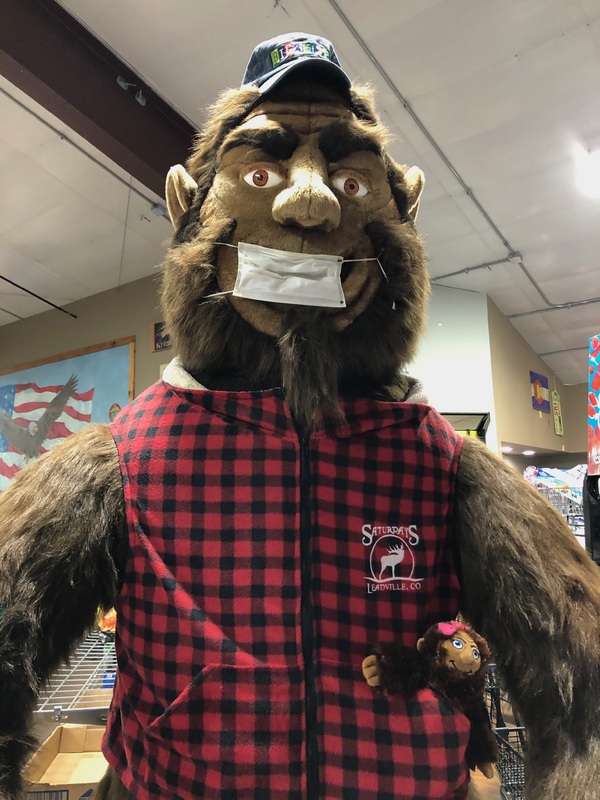
2020-07-25
Even the Bigfoot inside Saturday's discount store/gas station in Leadville, Colorado wears a mask. I took this photo while getting gas and snacks over the summer. It made me smile after a hard week- if Bigfoot can do it, so can I.
-
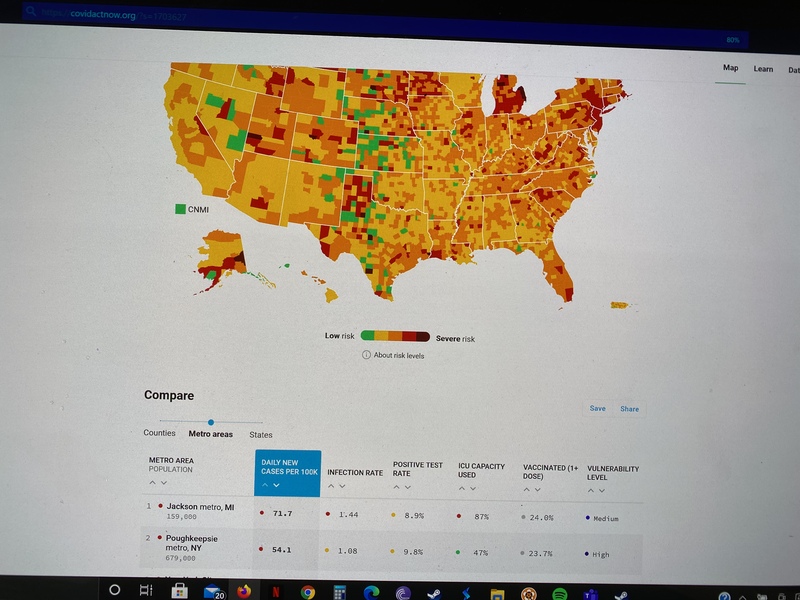
2021-03-26
While I was looking around the internet for updates on COVID, I came across the information from www.covidactnow.com that Jackson, Michigan was the top Daily New COVID Cases per 100k people in the country. This was on March 26, 2021. As of April 10, 2021, (when I submitted this information) Jackson was still in the number 1 metro spot. This where my family lives & where I work. This was very upsetting to me.
Many people still don’t wear masks. And if they do, many wear them under their nose. In some ways, I’m not surprised (but disappointed) that the virus really started to circulate here because of the way the community doesn’t respect public health orders.
-
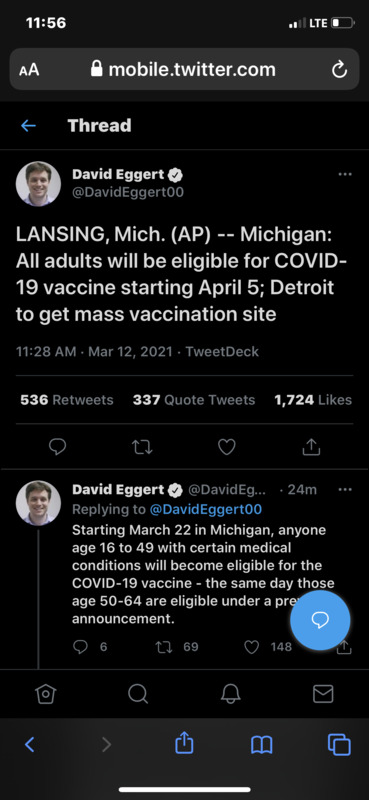
2021-03-12
I am on Twitter. I have used Twitter as a news source since before the pandemic broke in early 2020. This is a screen shot of how I learned my husband (who has pre-existing medical conditions & is 43 years old) & I ( 38 years old) would be eligible to get vaccinated. I will never forget this moment. I felt elated, joyful, & relieved. It was like a cloud that I didn’t even know was looming over me had lifted.
-
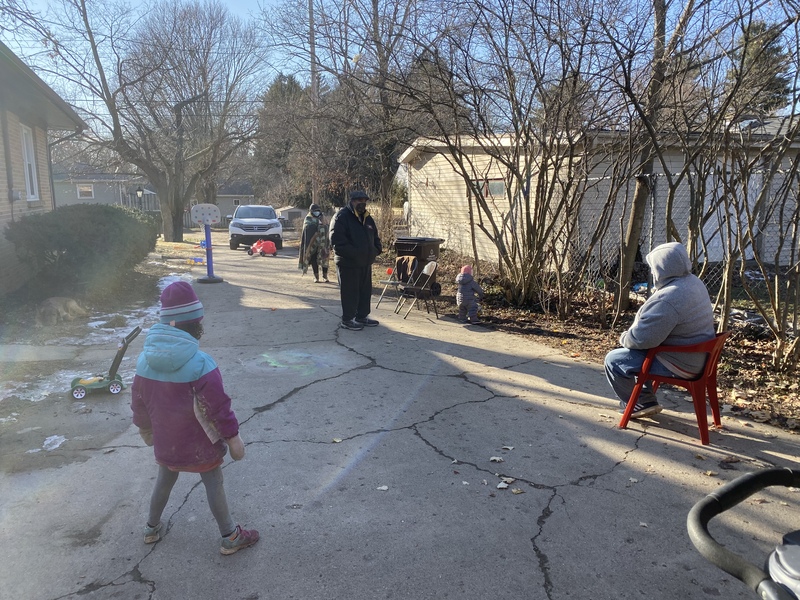
2021-03-06
Wanting to see the grandkids, my in-laws stopped by. They live about 45 minutes away. Everyone was outside, keeping about 6 ft apart with masks on while the kids played.
-
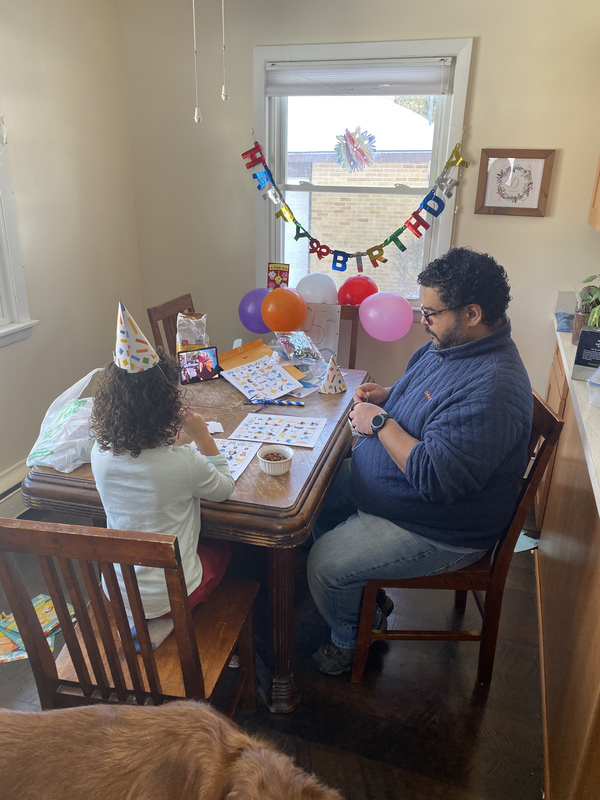
2021-02-19
My daughter turned five on February 19, 2021. We had no family or friends over to celebrate. We had individual Zoom calls with each set of grandparents & a Zoom birthday cake celebration with all of the aunts, uncle, cousins, a great aunt & grandparents late in the evening.
People sent their gifts ahead of time. She opened them throughout the day. We gave our daughter her birthday gifts, too.
This particular photo is showing virtual Bingo. One set of grandparents sent over a Bingo card set & they had a copy of the same one. We played the game virtually. My daughter had a lot of fun.
-
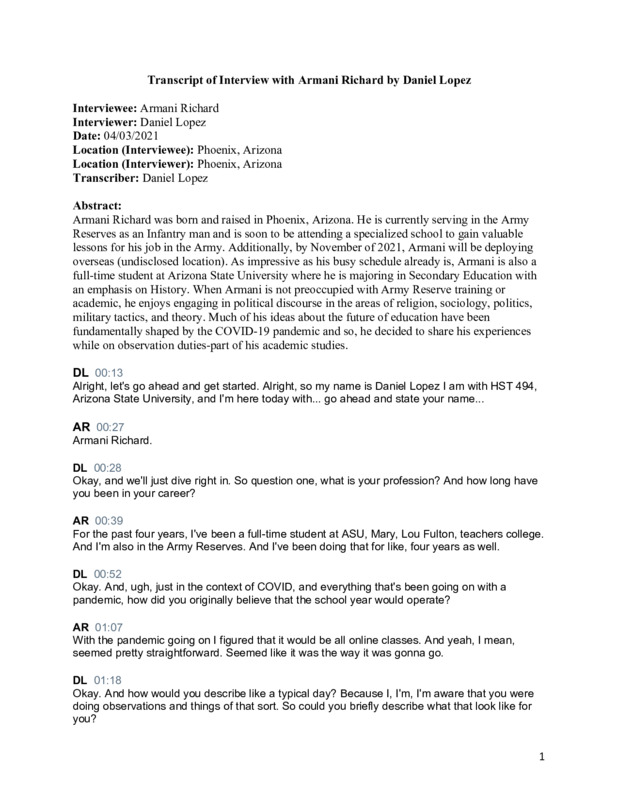
2021-04-03
Conversation with Armani Richard and the impact of COVID-19 on Arizona education. Currently studying at Mary Lou Fulton Teachers College and fulfilling a promising career in the Army.
-
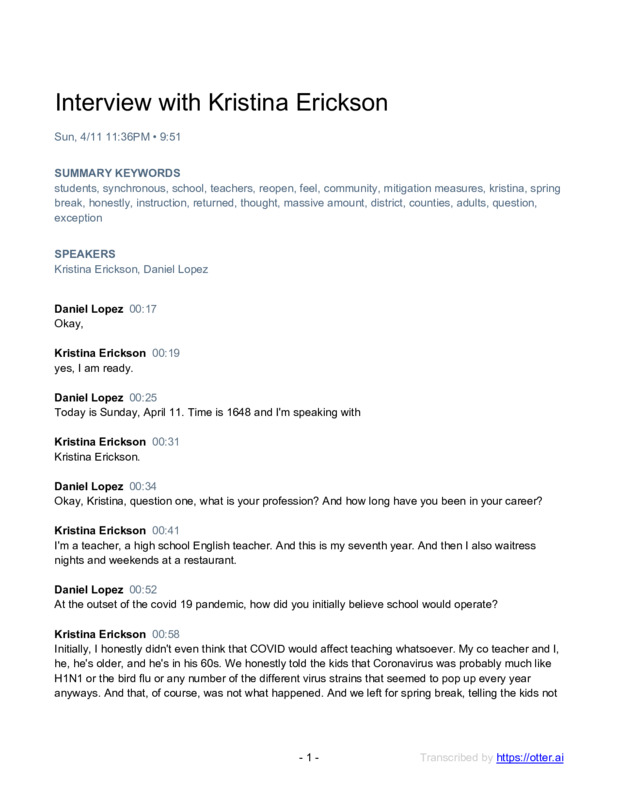
2021-04-11
Conversation with Kristina Erickson an Arizona K-12 educator. Ms. Erickson weigh-ins on the March 15th executive order, in-person instruction, COVID protocols and procedures, and the future of education in her community
-
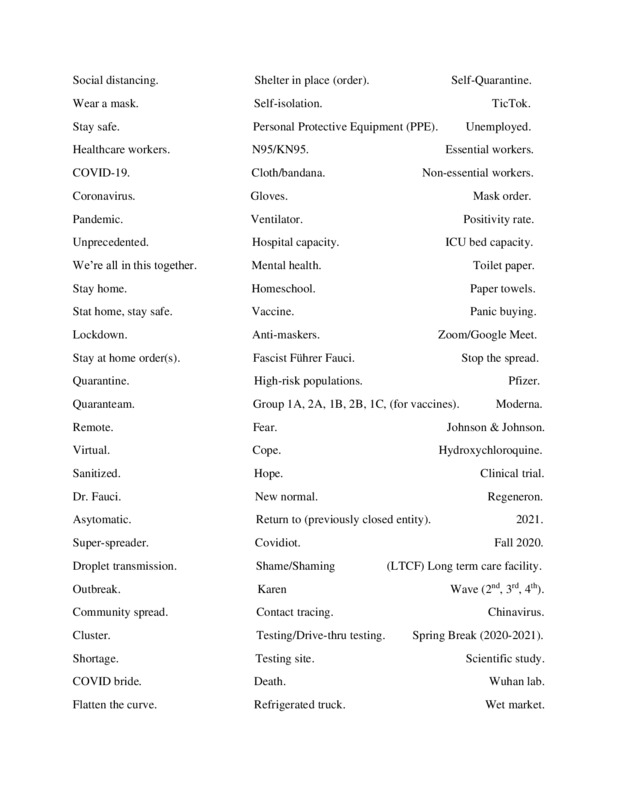
2021-04-12
This is a comprehensive (but not exhaustive) list of the most common Corona themed vocabulary used by in the U.S. While a definition of each term is not provided, linked websites provide context and explanations of many of the words. Culled from a variety of real world sources, what is most important about these terms is what their use says about the culture they created/were used in. From the use of everyday pandemic language, researchers can gain a window into the COVID experience in a way that is inaccessible even in photographs. These terms also show the United States was undergoing dramatic social and cultural change and some terms highlight the political conflict that was often meshed with Corona in the U.S. The vocabulary also shows a degree of conformity in U.S. culture as all of these terms became part of most Americans' vocabulary. The case of the work "healthcare worker" and "virtual" are two examples of this. Before medical staff, nurse doctor, EMT, online, distance learning, etc. were used to refer to these things, but now Americans have dropped them for the COVID versions. This shows how powerful Corona vocabulary has become.
-

2020-11-01
Hello,
My name is Melaine, I live in Hughesdale, Victoria, Australia and I would like to share this story of subtle community spirit that came through during the COVID-19 Pandemic of 2020.
I am also legally blind.
Thank you for your time.
Melaine
-
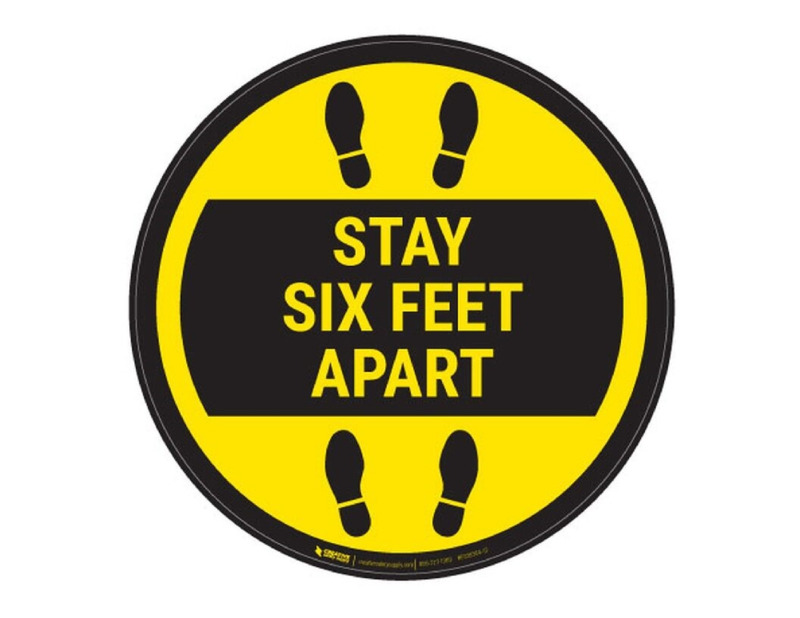
0004-04-12
This is an image of a sign that says stay six feet apart. This "six feet apart" phrase was created because of the CDC guidelines that if you stay six feet apart from another person you are "safe" from contracting COVID-19.
-
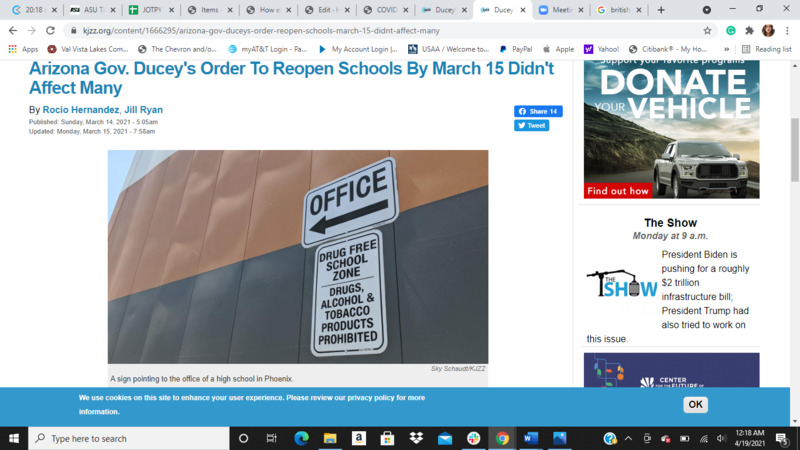
2021-04-11
On March 11, 2021, the Arizona State Health Department reported seven counties, including Maricopa, were coded as "substantial transmission rate", however, this rate is technically one level under the serious risk categories. The remaining counties (six) were deemed "moderate" and were set to reopen by March 15. The NPR article argues about the irrelevancy of the order because more than half of the schools in the county are offering some form of in-person instruction, this order didn't change much for that particular school. For some schools, Osborn and Cartwright, the order actually sped their reopening date. In the Osborn case, school officials pushed for reopening because they confirmed that more than half of their teachers had been vaccinated. In places like Coconino and Pinal counties where transmission levels are exceedingly high, the school districts are exempt from reopening. Again, the effectiveness of the March 15th executive order is questionable at best.
-
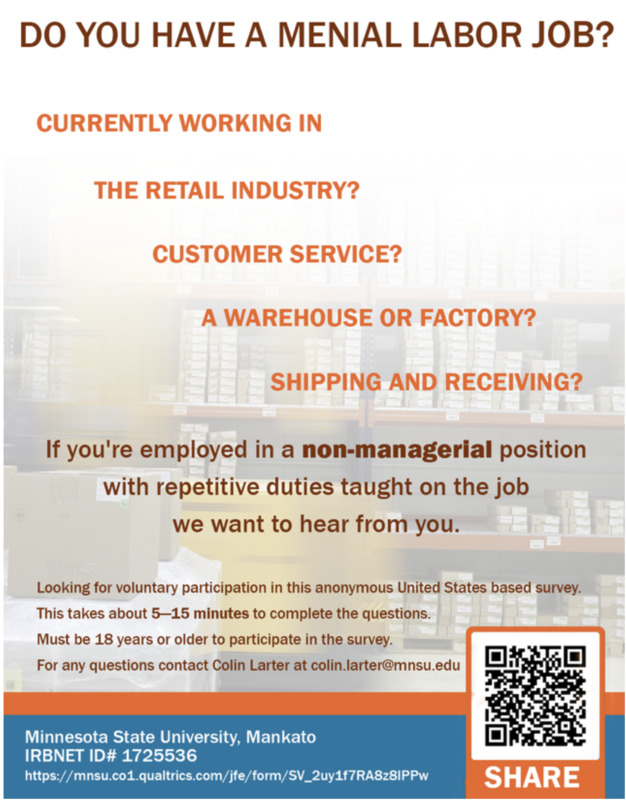
2020-04-10
Graduate student Colin Larter from Minnesota State University is seeking participants for a survey focusing on service industry and factory workers to share their experience about their jobs. The survey is completely anonymous, and he is planning to utilize the data he gathers for his thesis. As a former retail worker, he understands the importance of sharing these experiences. This flyer was shared on the Target reddit page, and likely other places on the internet, in hopes that there would be a variety of individuals participating.
-

2020
Because of the struggle the pandemic has put on small businesses and restaurants, Thrillest has created a webpage that lists a variety of businesses with links to merchandise, donation pages, and places to buy gift cards. By providing this support, Thrillest is trying to prevent any small businesses from closing due to the pandemic, and are spreading the word about small businesses that need support to encourage people to support them rather than large companies that aren't necessarily struggling during this time. They hope to serve the service industry, providing direct support for businesses in many major cities across the U.S.
-
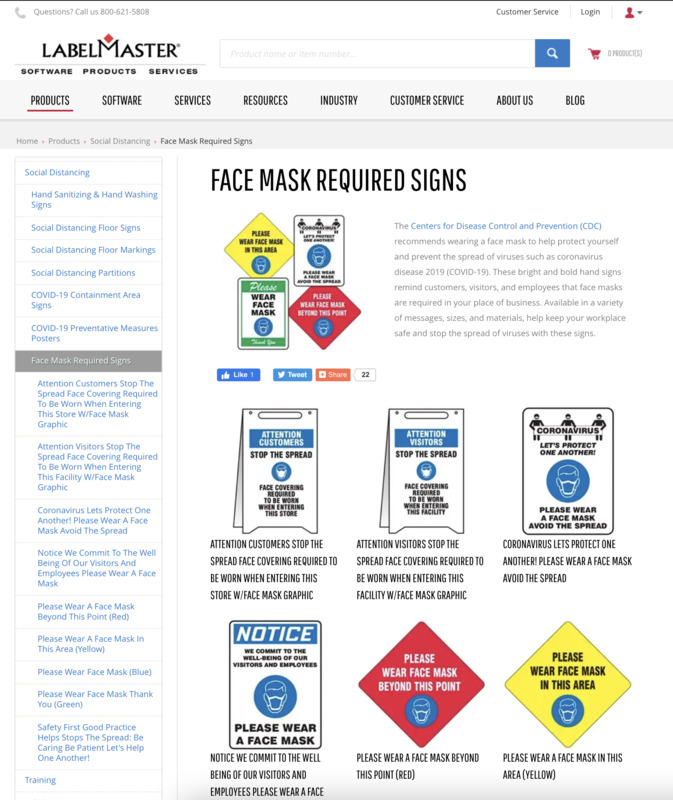
2021
While some states are lifting their mask mandates, many regions and companies are still asking people to wear them in order to protect both employees and fellow individuals. While there are official printable signs available from both government sites and the CDC, there are also more stable signs for sale that can be displayed at places of business. This shows how industries adapt to current issues, as two years ago these signs were nonexistent, but are now fairly common at places that would like to protect their employees. Even with signs such as these, there is still conflict arising regarding masks, more than a year after the pandemic became a worldwide concern. These signs are an additional expense for businesses, but could prove to be more noticeable than a paper in the window.
-
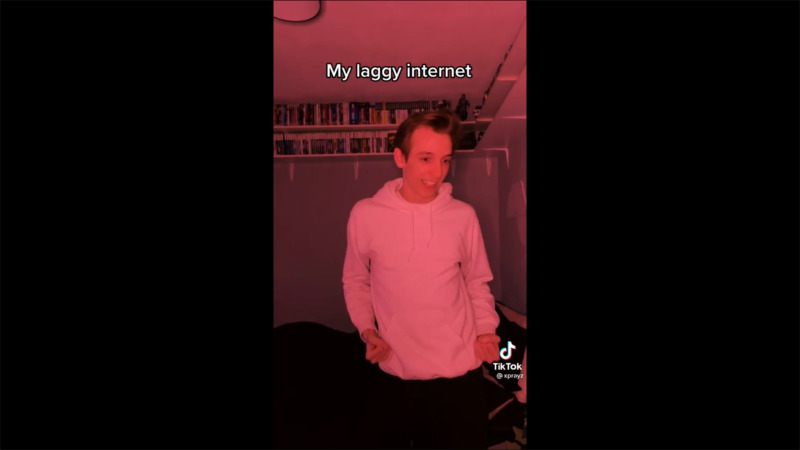
2021-03-21
This video utilizes a Tiktok trend involving a specific audio as well as filter to illustrate internet issues an individual is facing. The audio is a clip from the song 'Got Me Good' by Ciara.
-
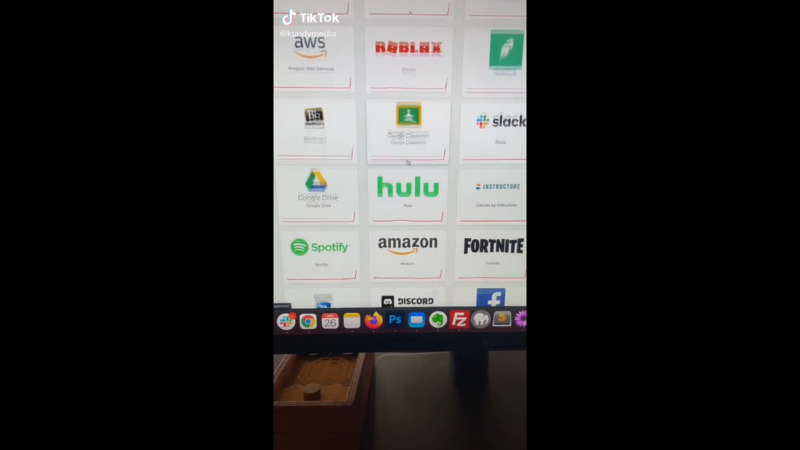
2024-01-26
This tiktok is from an individual showing several site outages/internet connectivity issues across multiple major sites. The caption indicates that he was trying to complete his work when faced with this issue. He is utilizing a site that indicates which sites are down which is shown in the video.
-
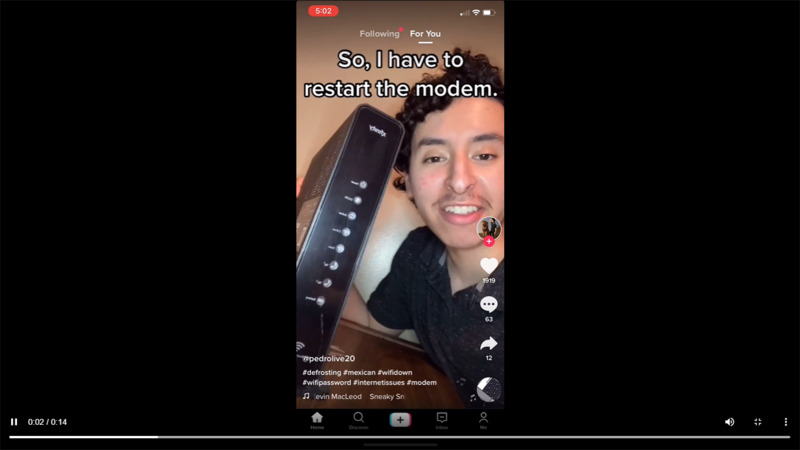
2021-03-11
This short video from Tiktok is about an individual dealing with internet issues and being frustrated about connectivity issues. It seems in part to be satirical as he unplugs and plugs the modem back in.
-

2021-04-11
This academic article is in the Lancet, a medical journal. I chose this because it is public, unlike some academic articles, and it is, as of right now, a pretty unique research article. Although it is done in the UK, it reviewed medical records, both physical and mental, from 2017 to 2020. The changes are a little surprising, as the largest reductions in health care at the start of the restrictions were diabetic emergencies, depression, and self-harm. This is something I have seen a lot in my research into the unintended consequences of the COVID-19 pandemic. Mental illness is the last thing to be cared for in a pandemic, or even in other natural disasters. The consequences on human health from this pandemic are only just now coming to light. This journal entry covers in-depth research and I highly suggest it.
-
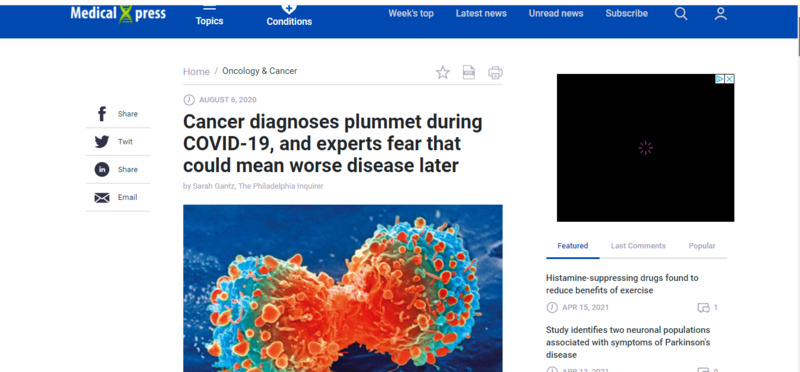
2021-04-11
I know I have presented a pretty eye catching and exciting title, but the fact of the matter is, they aren't going down. The amount of people who have cancer has not plummeted, as the title suggests. Rather, the statistics have gone down. As the article states, "new findings offer grim evidence of the consequences of delayed care: A rise in undetected cancers that, when eventually diagnosed, may be more advanced and difficult to treat." I think this is a great reminder that statistics are not the people they represent, and many things effect the numbers. This is relevant to my research on the unintended consequences of the COVID-19 pandemic.
-
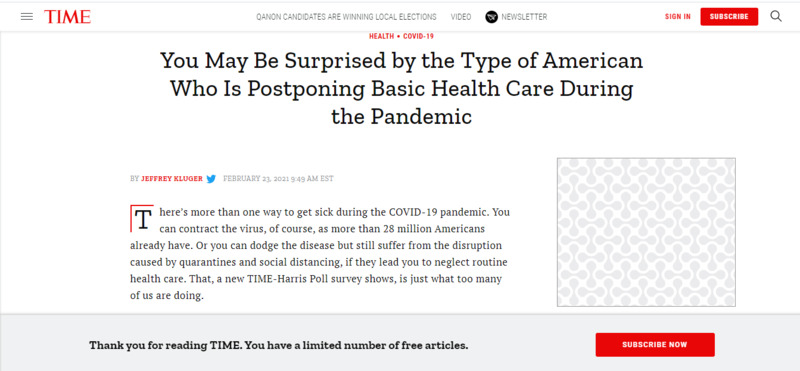
2021-04-11
I have been researching the unintended consequences of the COVID-19 pandemic. One consequence that interests me the most is people missing important specialist appointments for things like heart disease or cancer. I would have assumed that it would be the lower class skipping these appointments the most due to the fact that is many cases it is already harder for lower class people to get to regular appointments. But this article proves my thought wrong, and states that the lower and middle class people have less opportunity to miss these appointments. They tend to have more healthcare problems, according to the article, and therefore need the appointments more. In addition, the numbers might reflect the fact that lower income people don't go to the doctor as much as higher income people in general, therefore the numbers were low to begin with. The article is a very interesting read and I highly suggest it.
-
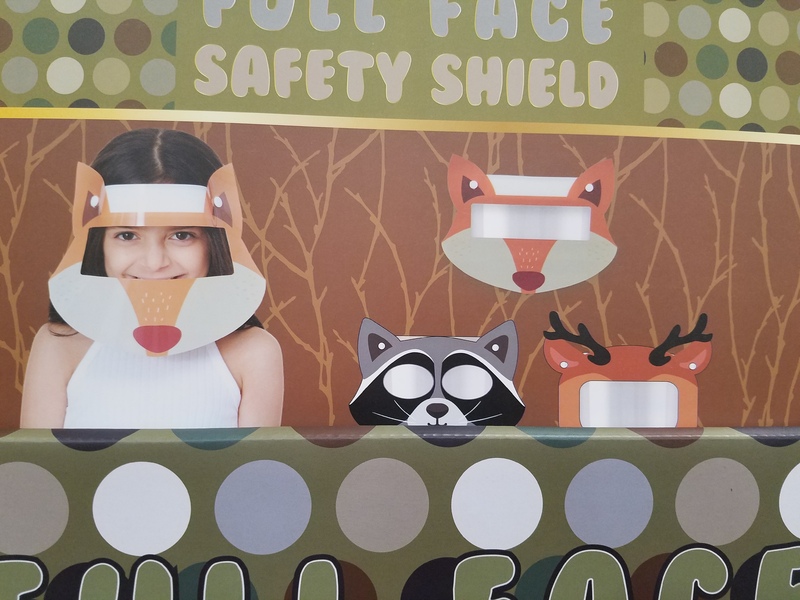
2021-01-21
These pictures are a collection of Corona themed products from summer 2020 to January 2021. As you can see, there was a great variety of products and some of the most unusual appeared starting 2021. Of particular note is the coffee mug and a small wall plaque. Even the infant phrases "Social distancing" and "Healthcare worker" had crept into daily items in real stores. By fall, masks were being advertised in stores on long plastic hangers and had become just as common on random aisles as dish gloves, scrubber pads, and dryer balls. By January 2021, companies had begun to get creative with masks and shields. The final picture shows a set of children's face shields encased with the features of animal heads. This was likely to appeal to children who like to pretend to be animals. One company also began to make masks in small, medium, large, and extra large, to accommodate the variety of face shapes among the public (not pictured). The most important thing about all these products is that they show how deeply embedded Corona had become in United States culture despite the fact that it was not even a year since the virus appeared in the U.S. This indicates that companies were actively involved in both creating and maintaining a COVID consumer culture that tied what people experienced to what they could buy. Although more difficult to determine, it also shows a demand for such items both out of necessity (masks) and for leisure or fun (mug, animal shields). These items also reveal that COVID-19 was a highly unique event in that it was so marketable. No other event in the 21st century generated as much cultural/societal presence as Corona. These products should be further studied to see what better understanding about Corona can be gained from them.
-
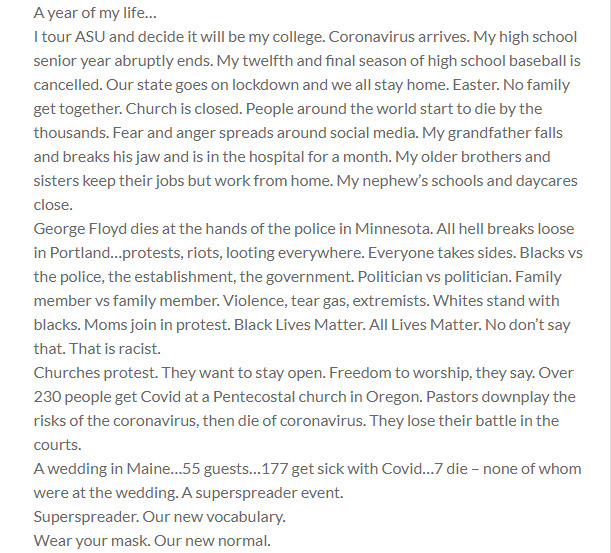
2021-04-11
A year of my life…
I tour ASU and decide it will be my college. Coronavirus arrives. My high school senior year abruptly ends. My twelfth and final season of high school baseball is cancelled. Our state goes on lockdown and we all stay home. Easter. No family get together. Church is closed. People around the world start to die by the thousands. Fear and anger spreads around social media. My grandfather falls and breaks his jaw and is in the hospital for a month. My older brothers and sisters keep their jobs but work from home. My nephew’s schools and daycares close.
George Floyd dies at the hands of the police in Minnesota. All hell breaks loose in Portland…protests, riots, looting everywhere. Everyone takes sides. Blacks vs the police, the establishment, the government. Politician vs politician. Family member vs family member. Violence, tear gas, extremists. Whites stand with blacks. Moms join in protest. Black Lives Matter. All Lives Matter. No don’t say that. That is racist.
Churches protest. They want to stay open. Freedom to worship, they say. Over 230 people get Covid at a Pentecostal church in Oregon. Pastors downplay the risks of the coronavirus, then die of coronavirus. They lose their battle in the courts.
A wedding in Maine…55 guests…177 get sick with Covid…7 die – none of whom were at the wedding. A superspreader event.
Superspreader. Our new vocabulary.
Wear your mask. Our new normal.
Another suicide in my school district. I turn 18. I am registered for classes at ASU but attending is up in the air. I work as a GrubHub deliverer because everyone is ordering food from home. We get together with family outdoors. I have a graduation party…in July. Graduated seniors get to play a couple of baseball games at the local minor league field. I am undefeated for my senior season. I pitch, hit, and field well. What might have been…
August comes. August 15…I move into Hassayampa…115 degrees…new roommate…I start college…I get Covid…so does my roommate…so does our suitemate…and many others…September 8…I move out of Hassayampa…my roommate and I move into an apartment. Life gets better. Fires sweep through Oregon. And California. And Arizona. ASU cancels finals week. Election. All hell breaks loose. Again. I move home before Thanksgiving. My brother-in-law gets sick with Covid 19. My brother and sister-in-law get sick with Covid 19. My first term of college ends. Christmas.
Politics. I won. No, I won. Sounds like kindergarten. These people run our government?
I delete most of my social media. I am sick of it. I am sick of everybody. Sick of this year.
January. ASU cancels spring break. Back to school. Things are different. The newness has worn off. Covid is a drag. School is a drag. I lose my best friend.
I go home. I go back.
Ice storm in Portland…power out…broken trees.
I go home. I go back.
Trying to keep going. Trying to survive. Class is a blur. I stare at the screen. The information goes through me. I am not there. I do my homework. I bomb my exams. My grades are ok…but am I learning anything? Who knows? Who cares? School will be over soon.
Virtual work. Virtual school. Virtual life.
I will finish the year with over 40 credits. I will never have stepped foot in a college classroom. I will never have talked to a college professor. I will have met very few people.
Fall will come.
I will be starting over.
We all will be.
I hope.
#REL101
-
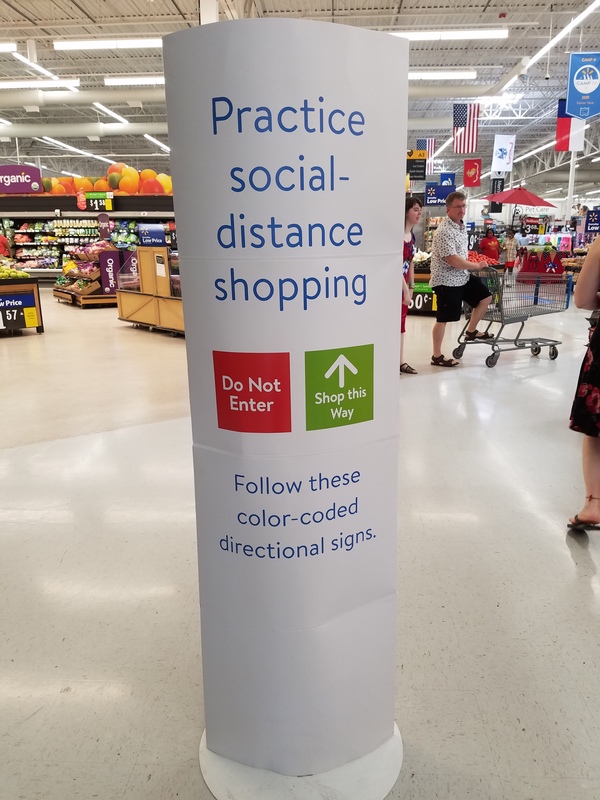
2020-05-28
These are pictures of one-way-only signs posted in a Texas Walmart on May 28th and June 11 2020. Many stores such as HEB, Target, and Sam's Club also had similar signs in there stores. The purpose of these signs was to encourage the public to walk in only one direction on each aisle of the store. Stores created an elaborate zig zag pattern using this method. At the time, it was thought that the risk of contracting COVID could be minimized by keeping people from congregating in the same space such as going in and out of the same aisle entrance. Some peopled followed the signs, but it was not a state law so others did not. These photos are important because they show the great extent stores took to try and minimize the spread of COVID. Stores were very concerned about projecting the image of a safe shopping experience in their stores. However, they also hint at the legalistic bent many COVID precautions were beginning to take on. Another implied effect of this arrangement was that by encouraging all people to go in the same direction, stores increased the risk that their customers might catch COVID-19 as everyone was to follow the exact path the person in front of them had. This was the type of situation these signs were supposed to prevent.
-
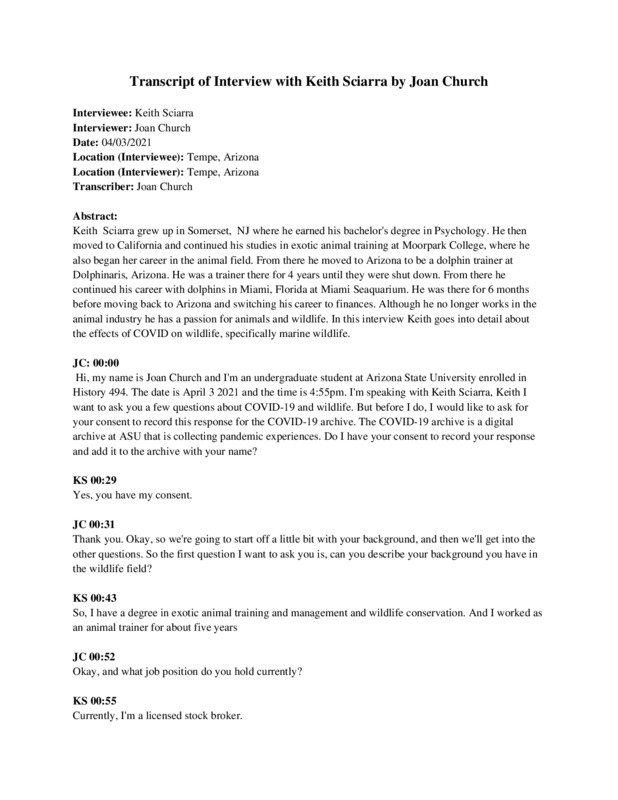
2021-04-03
This is an oral history interview with Joan Church and Keith Sciarra. Keith gives his insight on how covid-19 has affected wildlife. Keith has many years working within wildlife, specifically with dolphins and ocean life. He gives us advice on how we can help the cause after covid and talks on the topic of ocean conservation.
-
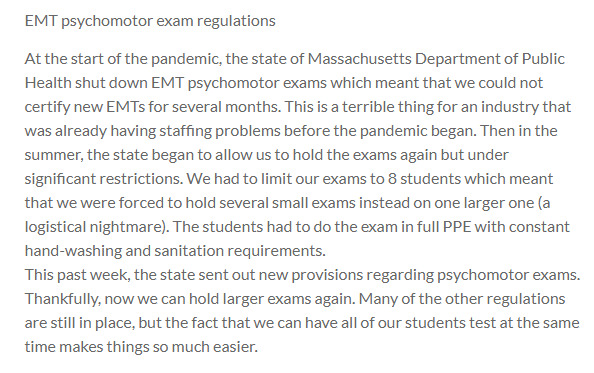
2021-04-11
At the start of the pandemic, the state of Massachusetts Department of Public Health shut down EMT psychomotor exams which meant that we could not certify new EMTs for several months. This is a terrible thing for an industry that was already having staffing problems before the pandemic began. Then in the summer, the state began to allow us to hold the exams again but under significant restrictions. We had to limit our exams to 8 students which meant that we were forced to hold several small exams instead on one larger one (a logistical nightmare). The students had to do the exam in full PPE with constant hand-washing and sanitation requirements.
This past week, the state sent out new provisions regarding psychomotor exams. Thankfully, now we can hold larger exams again. Many of the other regulations are still in place, but the fact that we can have all of our students test at the same time makes things so much easier.
-
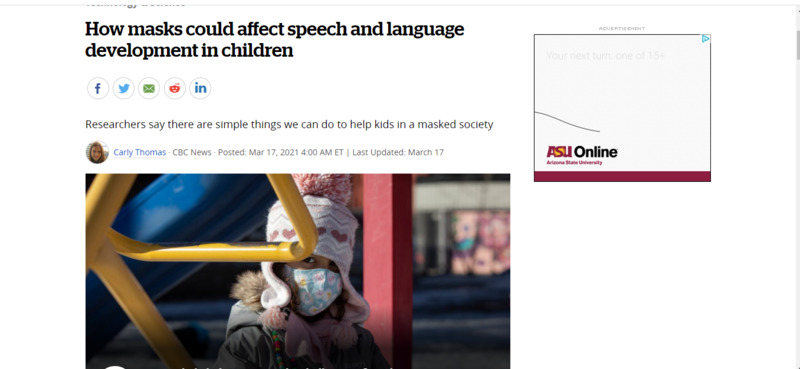
2021-03-17
There are socialization concerns among adults and adolescents, and most are aware of the reasons behind that. However, children still in early developmental stages (infants, toddlers) may struggle in the long-term.
The article primarily revolves around the words and expertise of senior scientist at Haskins Laboratories and a professor adjunct at the Yale Child Study Center, David Lewkowicz. There are physical, emotional, and mental struggles that could negatively impact early childhood development. Examples of these struggles are with how they learn languages by visual and auditory associations, which can be difficult with masks. Another related to masks is facial recognition.
Lewkowicz isn't filled with bad news, though. More time and direct attention given to face-to-face interactions and more explicit expressions of emotions can help compensate. These early years are when children are very adaptable as they take in the world around them, so there is hope for more perceptive children coming out of the pandemic rather than a decline.
-
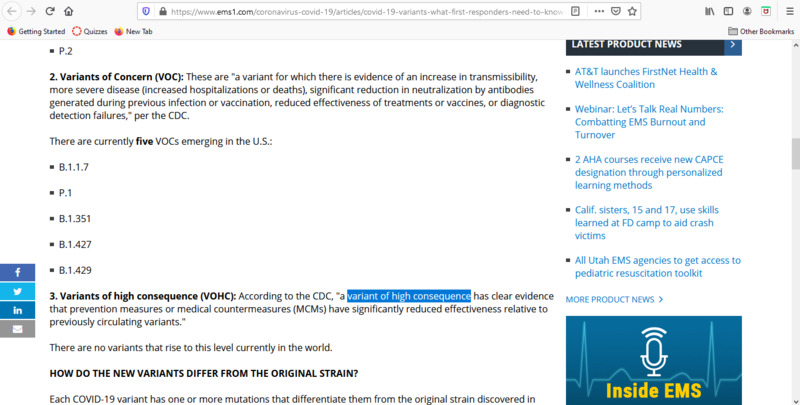
2021-04-06
This is an article about the variants of COVID-19 that are either present or emerging in the United States. It is meant to keep EMS providers informed with up-to-date information so that they can provide the best care to patients. Some of the variants are more dangerous/have more symptoms than others. It notes that there is 5 variants of concern, which have increased transmissibility and increased hospitalizations/deaths. While this is not great news, it is a good thing that there are currently no variants in the world that are considered variants of high consequence by the CDC, which essentially means that medicine does not have effective means of treating it. Hopefully this remains the case and we can start to see a drop off of the variants of concern soon.
-

2021-04-07
Gov. Andrew Cuomo, the controversial governor of New York, announced earlier this month that they plan to build a monument to first responders in New York City. First responders were among the group of people that were on the front lines of the pandemic response. This monument will be designed to honor the efforts and sacrifices by New York's first responders. In the coming months and years, I think we will see many other states do a similar thing for their first responders and healthcare workers.
-

2021-04-10
In order to relieve some stress for COVID-19 testing, the BC Children's hospital in Vancouver, Canada is supplying 1,200 testing kits to 1,000 schools. It's supposed to be replenished as needed. However, the main purpose is to make testing more accessible (without medical facility visitations). Those who show symptoms, or simply get a runny nose, may be sent home.
-

2021
California is soon expanding their vaccine eligibility to 16 and older on April 15, 2021. The plans for expanding it even more aren't expected to be for sometime. However, the announcement from Pfizer-BioNTech stating that the vaccine is safe and effective for 12 and older does give some hope for a quicker time frame.
The is a focus on giving children and adolescents back their youth. There are schools opening with hybrid instructions (online and on-site instruction), but there the on-site hours are always rotating students to minimize crowd interaction.
The article goes on to include opinions from parents of adolescents, which emphasized the importance of getting everyone (school faculty and students alike) vaccinated. Everyone seems eager to get back to pre-pandemic life as soon as possible, so the eligibility expansion does receive as good news and gives the public hope.
Naturally, however, it’s not all good news as people need to remain informed and cautious. The article reminds us that variants of the virus have the potential to harm younger children. Notably, it’s the B117 strain that’s been said by Dr. Michael Osterholm, director of the Center for Infectious Disease Research and Policy at the University of Minnesota, that can be “50% to 60% more contagious than other strains of Covid-19” from his observations of Minnesota schools.
-
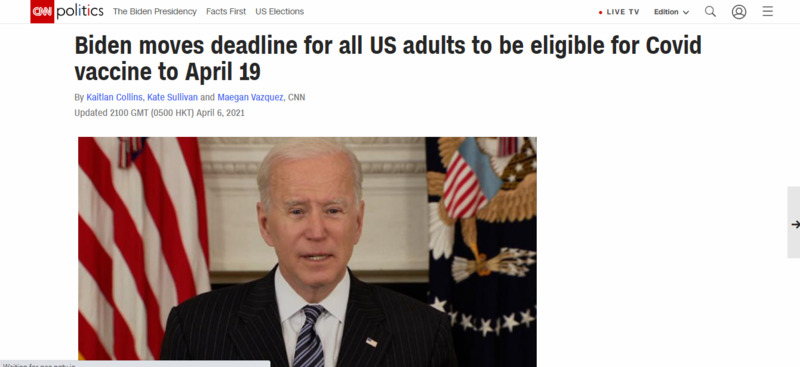
2021-04-06
With a goal of 200 million vaccine shots by the 100th day in office, President Biden announced that the deadline (May 1) for eligibility will move up to April 19.
Actions to vaccinate the country are speeding up. This motion will open up eligibility to “90% of adults”. States such as New Jersey, South Dakota and Nebraska plan to expand that eligibility to 16 and older even sooner to the deadline. Naturally, part of the process is to market the vaccine to the general public, especially to the ones hesitant to get the vaccine. That funding is coming from the COVID-19 economic relief package ($1.9 trillion).
-

2021-04-10
Californian schools are opening back up, but there continue to be concerns over employees and their families. Although there have been some employees working at schools the past year (i.e. custodians), those working remotely (i.e. teachers) continue to face challenges in child care. Due to this, "Los Angeles Unified School District earlier this week announced it would provide a day care stipend of $500 a month for each child under age 5 to all full-time employees, including teachers."
The Service Employees International Union (SEIU 1021) did clarify within the article by Sacramento Bee that some demands could not be met. Among the demands was a one-time stipend amount of $1,500 for employees with children aged 3 - 14. This is an ongoing issue with its latest update on April 10, 2021 being: a weekly stipend of $125 for employees with children aged under 14.
This represents one of the issues employees of educational institutions are facing. They’re hesitant to return to in-person instruction. Although there’s a fair amount of news coverage of children returning to school, the ones hesitant (especially those responsible for the school to run smoothly) should also be acknowledged.
-
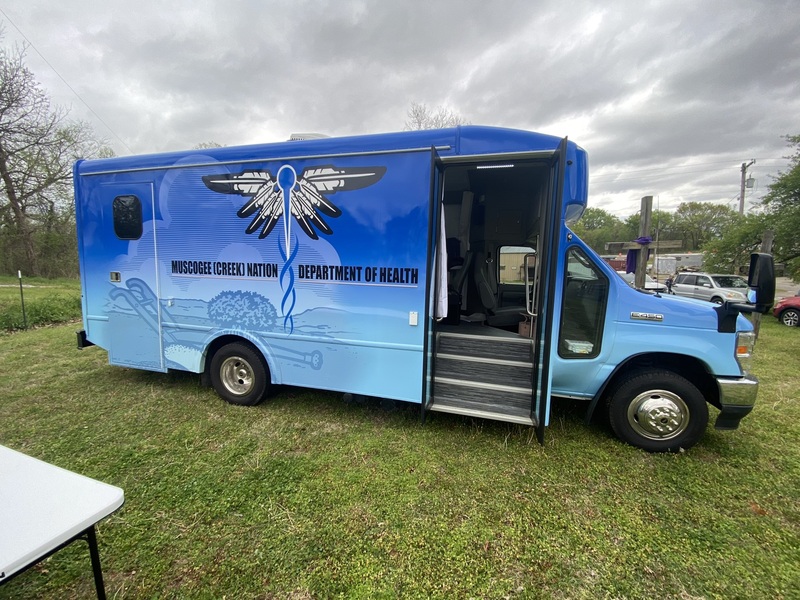
2021-04-10
The Muscogee Creek Nation began a campaign in Oklahoma to provide COVID-19 vaccines to rural residents. The mobile vehicles feature refrigeration units and enough room for three nurses to work on administering the vaccine, completing the paperwork, and entering the data to the online system. "I'm not aware of anyone else taking vaccine into communities via a mobile unit so we are really excited to be able to expand this service into our rural communities and we hope to increase vaccination rates because of it," said Shoneen Alexander-Ross, Chief Performance Officer with the Muscogee (Creek) Nation Department of Health.
-
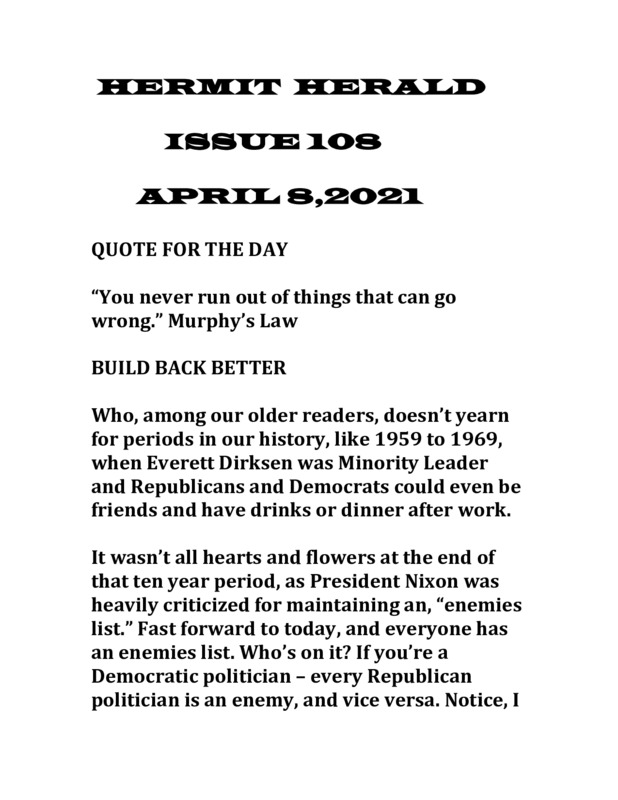
2021-04-08
Build Back Better
-
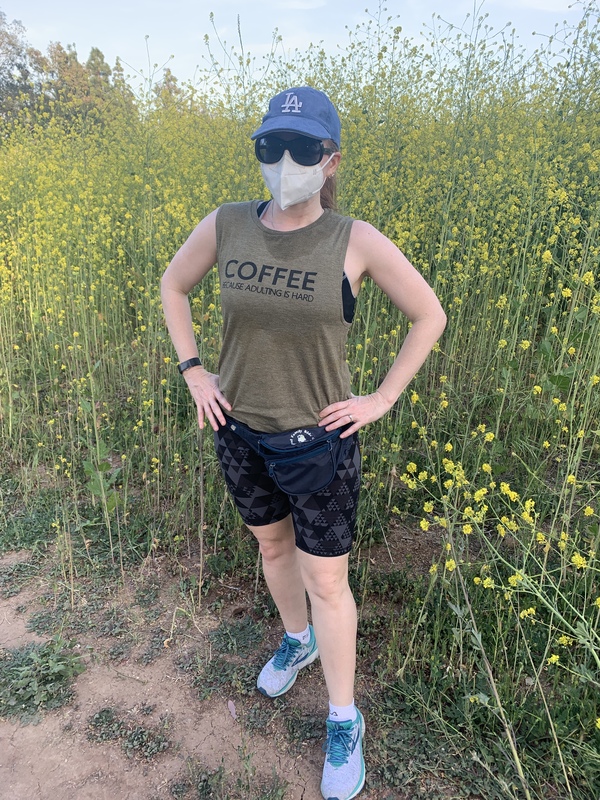
2021-04-10
Today was momentous. After 13 months, I ran a tentative (but amazing) five miles outside, in my neighborhood. I’d like to say it’s because now that I’m two weeks past my second dose of vaccine and back to teaching in person full time, I feel safe. Nope. It’s actually just that my best and most reliable quarantine companion, my treadmill, died. The poor motor is toast and even after taking it apart and trying to fix it, it is beyond repair. As a competitive trail runner, my treadmill was supposed to be a backup. It was never intended for daily use. I live in Southern CA, it’s a very rare day the weather isn’t great for running. However, quarantine turned my occasional treadmill run into a daily experience, but after a year, my low end, but loyal treadmill couldn’t take any more runs. I mean, I did run a marathon on the poor thing in December (and a variety of other virtual races throughout the year). So thank you trusty treadmill for getting me through this pandemic year. Thanks for not only supporting my daily runs, but also the 9 - 15 miles walks I would take on you while grading. Thanks for letting my daughter run on you three times a week to stay in shape for competitive gymnastics. And thanks for waiting to die until two weeks after my second vaccination. And most of all, thanks for dying and forcing me back out (fully masked) into the world I love running in so much.
-
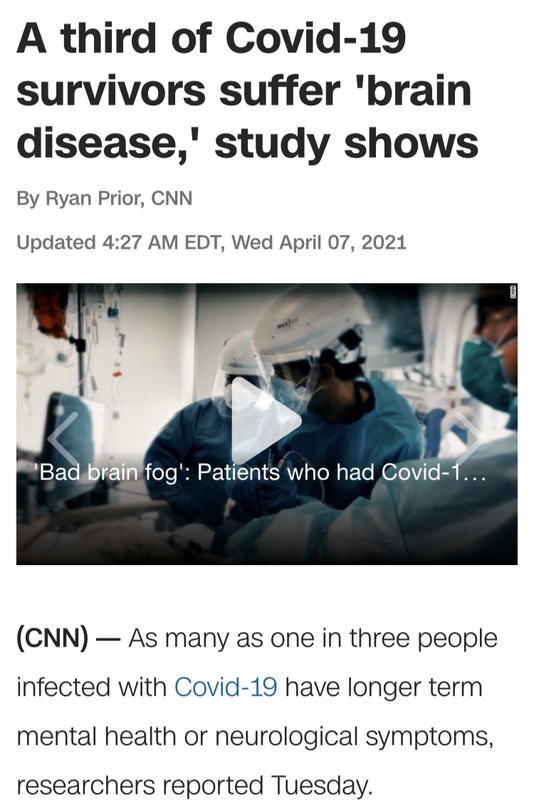
2021-04-07
COVID-19 has gone through a number of classifications. First as a “flu,” then as a “respiratory disease,” then as a “vascular disease,” and is in more recent studies, as a “brain disease.” Some reports are finding that one out of three COVID-19 survivors have mental health and/or neurological issues. This not only informs us of the complexity of COVID-19, but also brings light to the need to continue medical and psychological support of COVID survivors. Some survivors are described as having PTSD, and anxiety disorders are being diagnosed in a number of survivors. Neurologically, many survivors report “brain fog” and other issues. Another unexpected toll the virus takes on those infected.
-
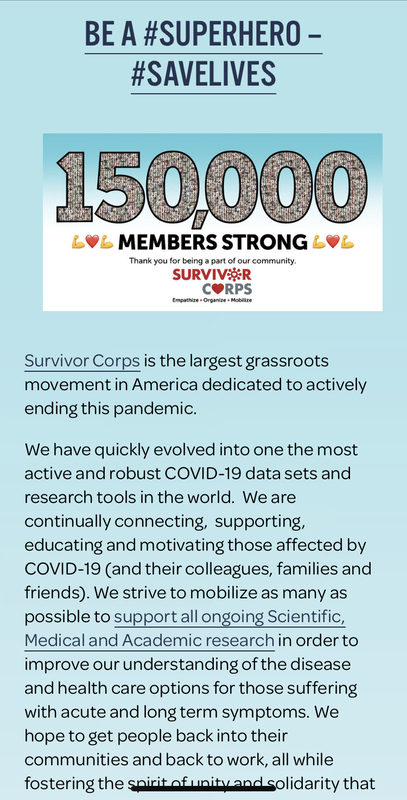
2020-03
One of the more positive outcomes of COVID-19 has been the mobilization of people to support one another and help mitigate the spread of the virus. Survivor Corps, started by an early COVID-19 patient, is “a grassroots solution-based movement to mobilize the sharply increasing number of people affected by COVID-19 to come together, support and participate in the medical and scientific research community efforts and take a more active role in trying to mitigate this pandemic.” Organizations such as this demonstrate the best in people and our potential and desire to work toward the common goal of beating this virus.
-
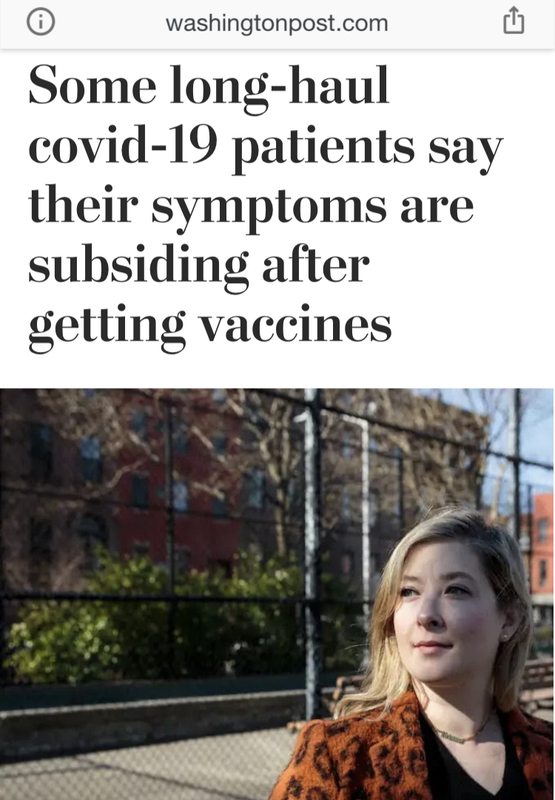
2021-03-16
When it comes to COVID-19, it seems there are more questions than answers. For some COVID-19 survivors, their COVID experience didn’t end after their infection ended. These people, referred to as “long haulers” have dealt with fatigue, brain fog, muscle aches, breathing difficulties, and insomnia. However, a surprising and potentially positive development has come out of the vaccine - long haulers symptoms are disappearing! Many patients struggling with long term COVID effects are reporting these effects disappearing after receiving their vaccination. Research, of course, needs to be conducted to pinpoint why, but this seems to be another light at the end of the tunnel for so many people who have struggling with long term COVID symptoms.
-
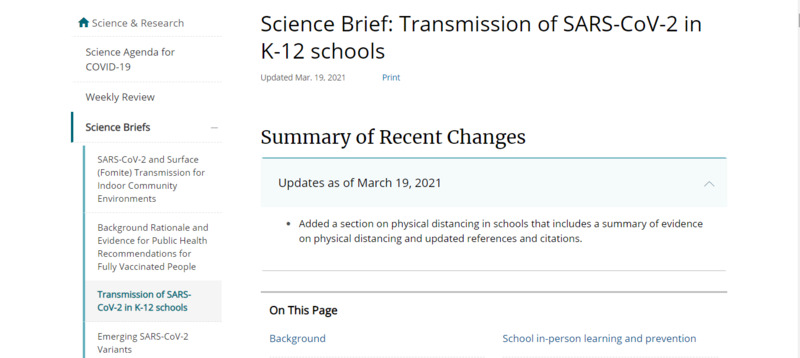
2021-04-10
(updated March 19, 2021) CDC report on scientific findings in terms of COVID-19, children, adolescents, and the unlikely transmission potential among these two groups (18 or younger). The experiences of other countries opening at various points during the pandemic contribute to the knowledge laid out in the report. One example of a recommended prevention strategy, physical distancing, is explained as a determining factor in preventing transmission. Yet, as the research shows, the prescribed 6-foot distance is less of a stress point when observing children and adolescents. In other words, several US studies have found low transmission rates when children are separated less than 6 feet. The same applies to children and adult interactions.
-
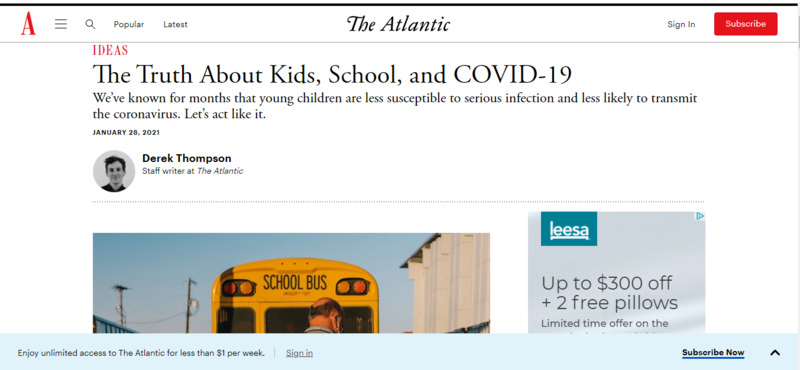
2021-04-10
This article, from The Atlantic, analyzes the Centers for Disease Control and Prevention (CDC) assertion that adequate ventilation, proper face coverings, and social distancing in schools will prevent transmission and a surge in COVID-19. The CDCs argument, which the author of the article fully supports, bases their support for in-person instruction on the "preponderance of available evidence," which includes both US studies and European. According to the CDC, people under 18, and young children especially, are less likely to infection and less likely to suffer severe symptoms. Moreover, one comprehensive plan to return children to the class includes access to vaccinations, high-quality scientific information, and strict COVID protocols.
-
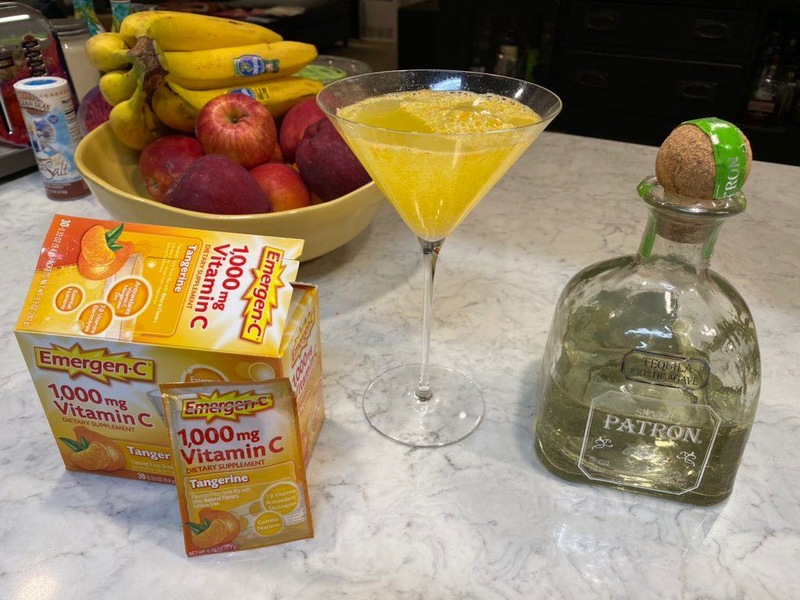
2020-03-14
The photo is a simple picture but I think it gives in insight into what many people were doing during the pandemic. It's a picture of a tequila bottle and a pack of Emergen-C. I know personally along with many of my friends we were drinking a lot during the time of being in lockdown. There was not much to do and we could only do so much staying indoors. We would watch tv, eat, sleep and do it all over again. The picture shows that while we were trying to staying healthy we were also drinking our days away.
-
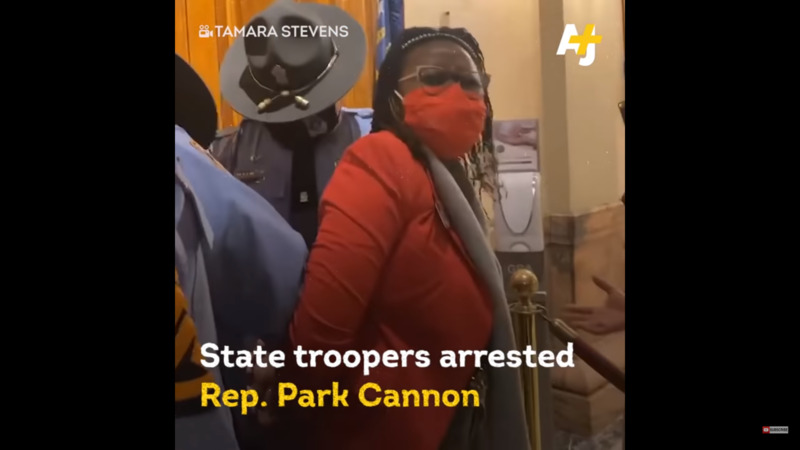
2021-03-26
State troopers arrested a Georgia lawmaker who was knocking on Gov. Brian Kemp’s office door, in protest of the closed-door signing of a bill that would restrict voter access. Critics, including Rep. Park Cannon, say the new laws will disenfranchise Black and Democratic voters.
“I am not the first Georgian to be arrested for fighting voter suppression. I’d love to say I’m the last, but we know that isn’t true.”
-
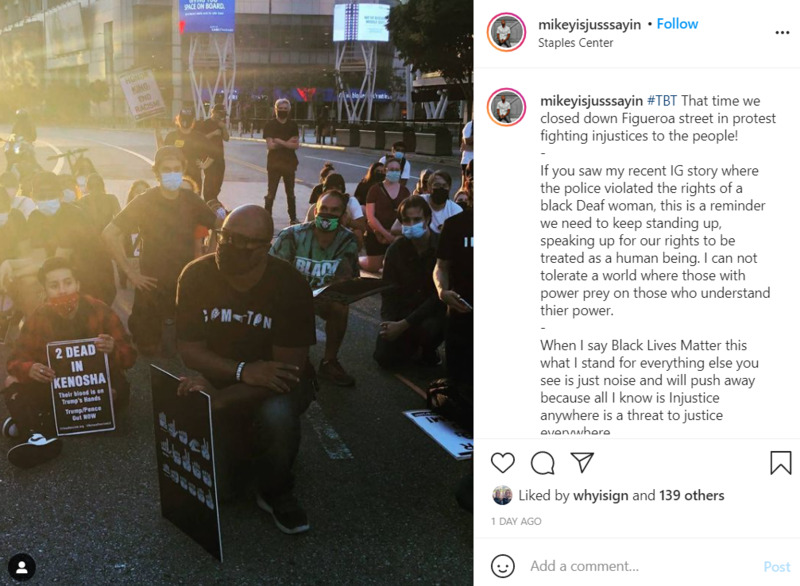
2021-04-09
#TBT That time we closed down Figueroa street in protest fighting injustices to the people!
-
If you saw my recent IG story where the police violated the rights of a black Deaf woman, this is a reminder we need to keep standing up, speaking up for our rights to be treated as a human being. I can not tolerate a world where those with power prey on those who understand thier power.
-
When I say Black Lives Matter this what I stand for everything else you see is just noise and will push away because all I know is Injustice anywhere is a threat to justice everywhere.
-
Stand with Me. Let's do our part to shape a better world. Power to the People all the time.✊🏿
-
📷 Gratitude @aanaconda
-
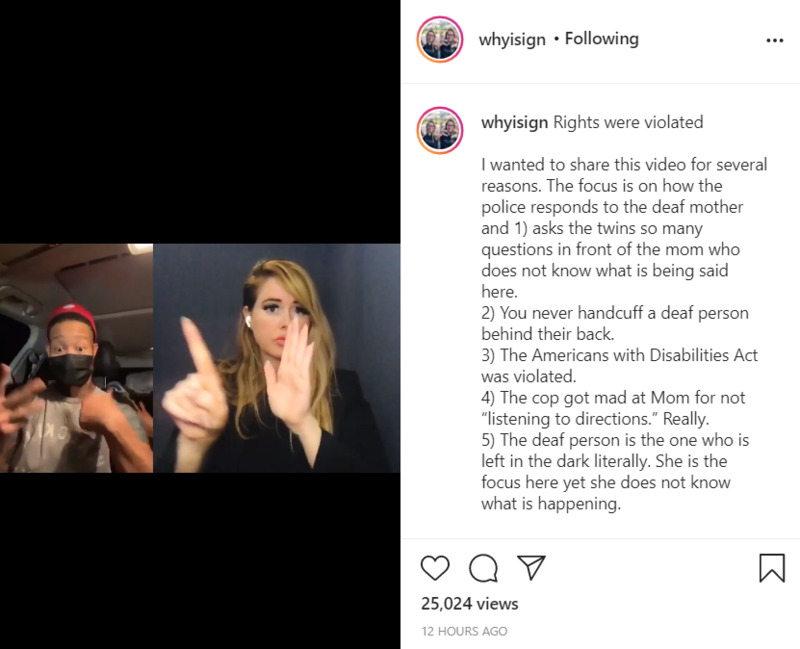
2021-04-09
Rights were violated
I wanted to share this video for several reasons. The focus is on how the police responds to the deaf mother and 1) asks the twins so many questions in front of the mom who does not know what is being said here.
2) You never handcuff a deaf person behind their back.
3) The Americans with Disabilities Act was violated.
4) The cop got mad at Mom for not “listening to directions.” Really.
5) The deaf person is the one who is left in the dark literally. She is the focus here yet she does not know what is happening.
Unfortunately, this is too common in deaf and hard of hearing people’s experience with the police. This should not be the common experience in dealing with the police.
There are more reasons, but the point is… this is one reason why the deaf people are so hesitant about getting help/support from the police. I hope this video as traumatizing, becomes a lesson. Police reform is much needed in so many areas, including learning how to communicate & how to work with deaf and hard of hearing people, the DO’s and the DON’Ts as seen here. I hope to see more training with the police departments in understanding how to work with deaf and hard of hearing people. I pray for healing for Mom- @burgundre Drizzy, and her twins. You can go and support her as she fights this.
Trigger warning here. Posted @withregram • @kelly4access 11 year old twin girls are forced by police (Michael Rose of the North Las Vegas PD) to interpret for their deaf mom and are interrogated while she is handcuffed. @burgundre recorded recorded her encounter on FB Live. Thanks so much @dpantv for working late in the night to make this accessible!! #asl #captions #signlanguage #police #discrimination #injustice #ada #policebrutality #whyisign #askmewhyisign
-
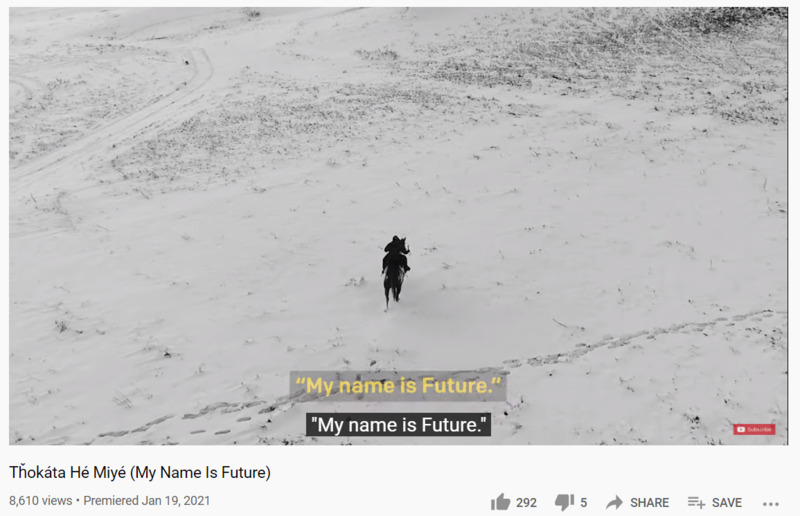
2021-01-19
A film by the Standing Rock Sioux Tribe and Earthjustice
Written and Directed by Josué Rivas
Narrated by Grace DeRockbrain
Cinematography by: Josué Rivas, Adam Johansson. Drone2Bwild, Digital Smoke Signals, Akicita Film
Edited by Dylan Sylwester
Audio by Natalie Huizenga
Community Outreach and Recording: Sunshine Woman Grace DeRockbrain (Standing Rock Sioux Tribe) Teena Pugliese and AnnaLee Yellow Hammer
Translation: Doug Goodfeather
Co-Producers: Rebecca Bowe and Chris Jordan-Bloch for Earthjustice
-
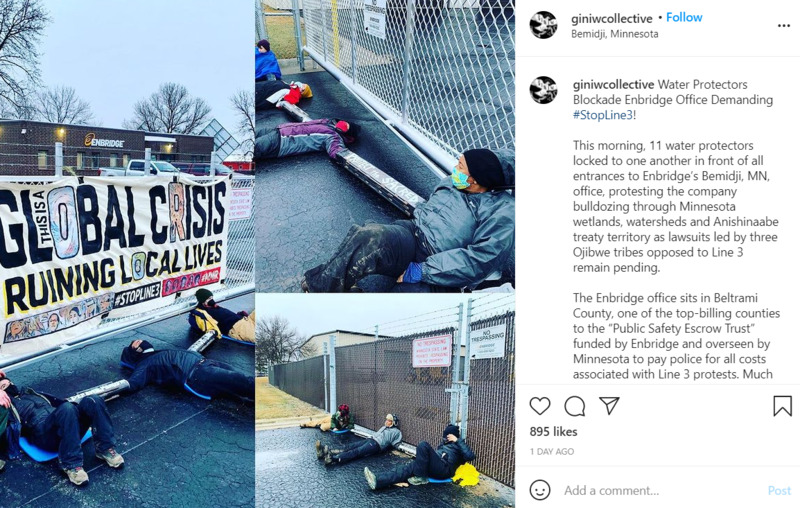
2021-04-09
Water Protectors Blockade Enbridge Office Demanding #StopLine3!
This morning, 11 water protectors locked to one another in front of all entrances to Enbridge’s Bemidji, MN, office, protesting the company bulldozing through Minnesota wetlands, watersheds and Anishinaabe treaty territory as lawsuits led by three Ojibwe tribes opposed to Line 3 remain pending.
The Enbridge office sits in Beltrami County, one of the top-billing counties to the “Public Safety Escrow Trust” funded by Enbridge and overseen by Minnesota to pay police for all costs associated with Line 3 protests. Much of Northern Minnesota has heavily militarized, purchasing riot gear, less lethal weapons and ammunition, etc.
Law enforcement along the proposed route have billed thousands of hours of “overtime” to Enbridge, with Cass County alone billing 7,500 hours to the Enbridge escrow account in 3 months. Indigenous people and local residents have reported heavy surveillance, targeted pullovers and harassment by law enforcement in connection with Line 3 resistance.
Water Protector Khalea said, “During Ferguson so many people came out and supported us, and I want to keep doing that... I am here for the liberation of all oppressed people, for the earth, for the liberation of all of our people, I am here to stand with Mother Earth and to protect the water and the wild rice and to stand with my Indigenous friends and loved ones as we all fight this collectively, we are all opposing these systems of oppression.”
Water Protector Alex said, “This is part of my responsibility as someone who is a guest on this land and as someone who faces the impacts of climate change. Enbridge lies.”
Water Protector Ishmaiah said, “I have spent the last several years fighting for the liberation in St. Louis, specifically Black St. Louis, and I see this as expanding and having a more holistic approach to what that fight can look like, because this land and this water touches us, and I think without that connection, grounding myself in the land and the water, doing solidarity with my Indigenous family, we can sometimes forget about the universal struggles around us.”
-
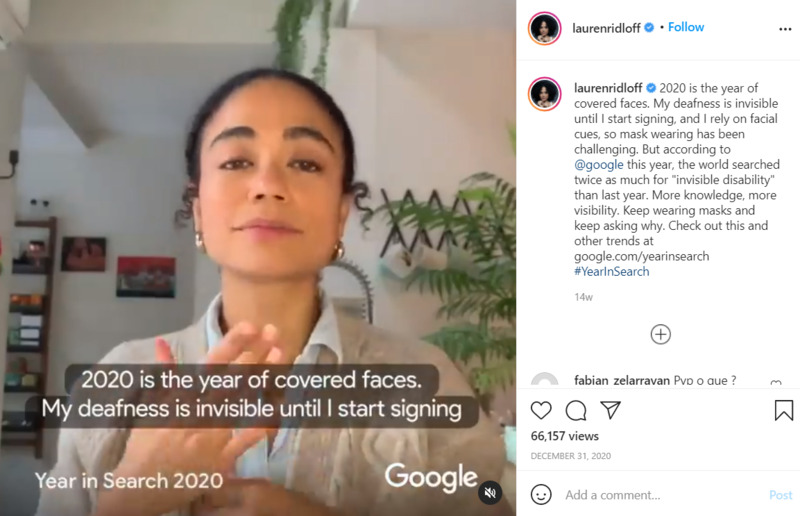
2020-12-31
2020 is the year of covered faces. My deafness is invisible until I start signing, and I rely on facial cues, so mask wearing has been challenging. But according to @google this year, the world searched twice as much for "invisible disability" than last year. More knowledge, more visibility. Keep wearing masks and keep asking why. Check out this and other trends at google.com/yearinsearch #YearInSearch
-
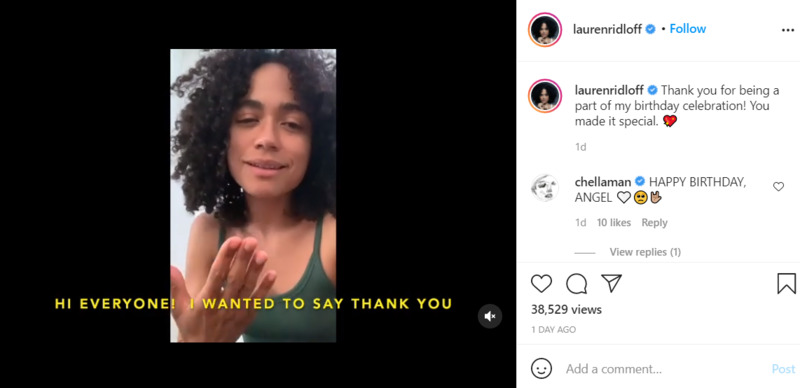
2021-04-09
Lauren Ridloff thanks their followers for making their second birthday in a pandemic a special one and encourages everyone to keep fighting.
-
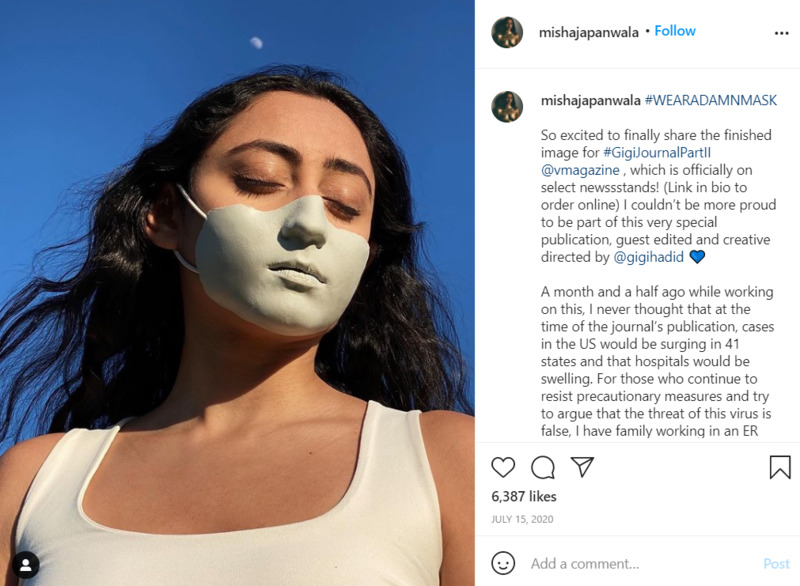
2020-07-15
#WEARADAMNMASK
So excited to finally share the finished image for #GigiJournalPartII @vmagazine , which is officially on select newssstands! (Link in bio to order online) I couldn’t be more proud to be part of this very special publication, guest edited and creative directed by @gigihadid 💙
A month and a half ago while working on this, I never thought that at the time of the journal’s publication, cases in the US would be surging in 41 states and that hospitals would be swelling. For those who continue to resist precautionary measures and try to argue that the threat of this virus is false, I have family working in an ER full of COVID patients in Tennessee right now, and can promise you this is very real. So please, wear a fucking mask and wash your hands! It’s the absolute least we can do.
Thank you to all the essential workers, who now 4 months in, are continuing to risk their lives by going to work every day. This work is in honour if you 💙
-
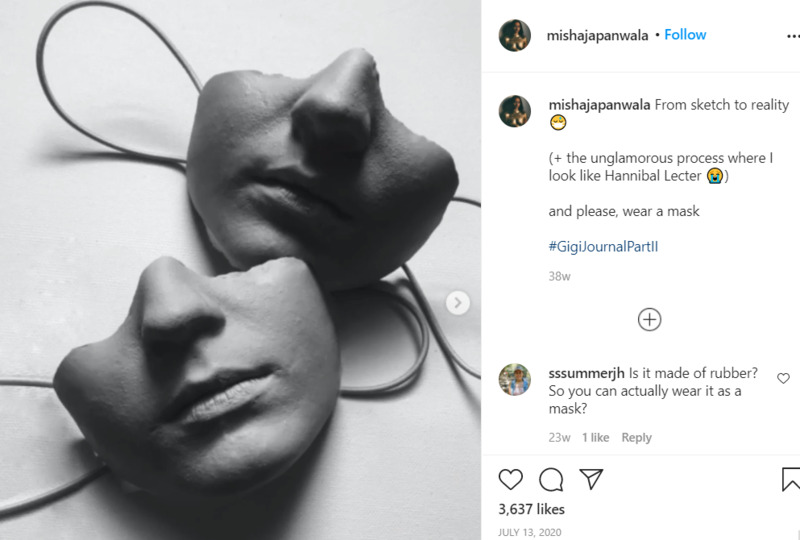
2020-07-13
Artist Misha Japanwala uses plaster as an artform. Here they made a plaster mold of their face and encourages people to wear a mask.
Misha said this in their post:
From sketch to reality 😷
(+ the unglamorous process where I look like Hannibal Lecter 😭)
and please, wear a mask
 2020-07-25
2020-07-25 2021-03-26
2021-03-26 2021-03-12
2021-03-12 2021-03-06
2021-03-06 2021-02-19
2021-02-19 2021-04-03
2021-04-03 2021-04-11
2021-04-11 2021-04-12
2021-04-12 2020-11-01
2020-11-01 0004-04-12
0004-04-12 2021-04-11
2021-04-11 2020-04-10
2020-04-10 2020
2020 2021
2021 2021-03-21
2021-03-21 2024-01-26
2024-01-26 2021-03-11
2021-03-11 2021-04-11
2021-04-11 2021-04-11
2021-04-11 2021-04-11
2021-04-11 2021-01-21
2021-01-21 2021-04-11
2021-04-11 2020-05-28
2020-05-28 2021-04-03
2021-04-03 2021-04-11
2021-04-11 2021-03-17
2021-03-17 2021-04-06
2021-04-06 2021-04-07
2021-04-07 2021-04-10
2021-04-10 2021
2021 2021-04-06
2021-04-06 2021-04-10
2021-04-10 2021-04-10
2021-04-10 2021-04-08
2021-04-08 2021-04-10
2021-04-10 2021-04-07
2021-04-07 2020-03
2020-03 2021-03-16
2021-03-16 2021-04-10
2021-04-10 2021-04-10
2021-04-10 2020-03-14
2020-03-14 2021-03-26
2021-03-26 2021-04-09
2021-04-09 2021-04-09
2021-04-09 2021-01-19
2021-01-19 2021-04-09
2021-04-09 2020-12-31
2020-12-31 2021-04-09
2021-04-09 2020-07-15
2020-07-15 2020-07-13
2020-07-13